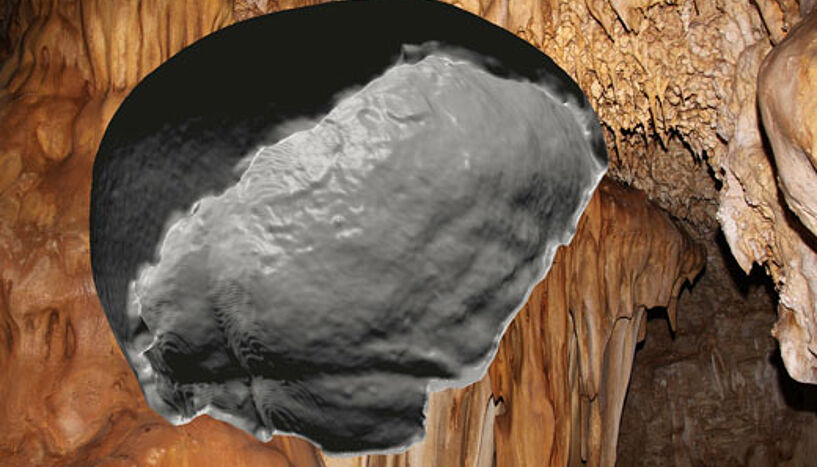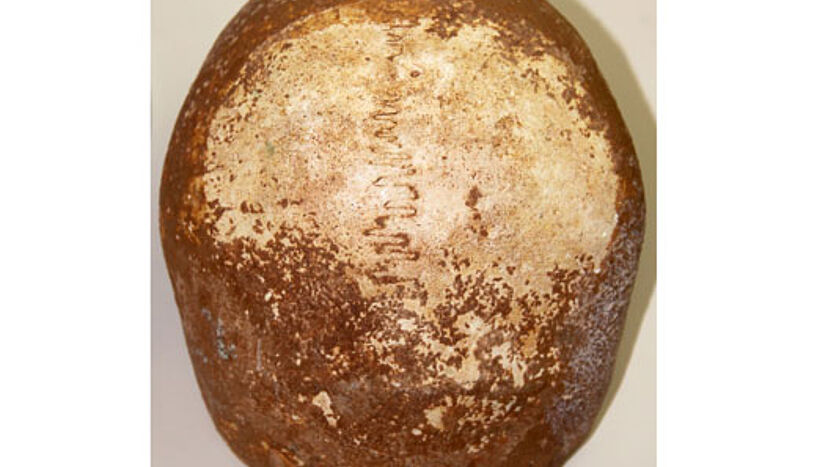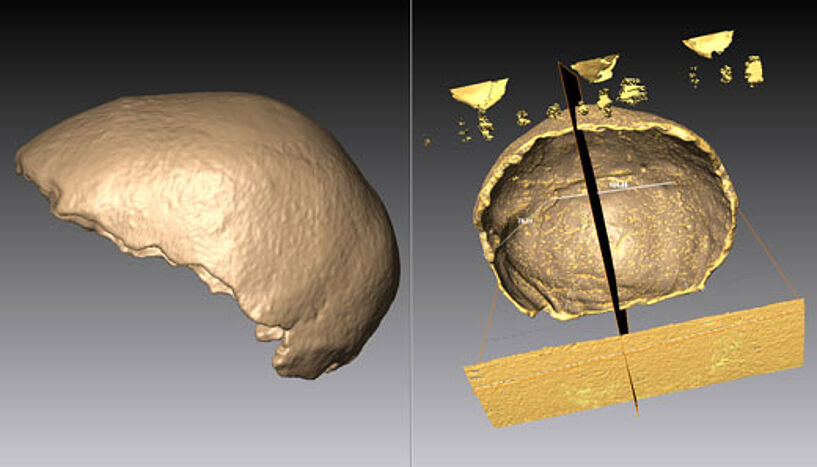Fossil Skull connects continents
28. Januar 2015How the first modern humans came to Europe
So far any trace was missing of those modern humans (Homo sapiens) who took their way from Africa to the North, arriving in Europe around 45,000 years ago and replacing all other forms of hominins. Now a finding from the Manot-Cave in northern Israel is closing this gap in our knowledge about our own origin. The approximately 55,000 year old remains of a braincase were investigated with state-of-the-art methods by Israeli scientists and anthropologists from the University of Vienna and the Max Planck Institute Leipzig. It turned out that the finding fits not only chronologically exactly into the so far unknown phase of migration out of Africa, but it also closes perfectly the gap in terms of morphology. Manot also changes our view with regard to our potential interbreeding scenario with Neanderthals. The research work was published in the renowned science journal Nature.
Manot is a karstic cave in the North of Israel, very close to the Lebanese border. The first excavations began in 2010 and are continued up to day. Countless archaeological objects were discovered which document the peopling of the cave since more than 100,000 years. Around 30,000 years ago, the roof of the cave collapsed and sealed the archaeological layers until the 21st century. Beside stone tools and animal bones, some few human remains were preserved. The most spectacular finding was made on an elevated shelf within a small chamber of the cave: a very well preserved “calotte”, hence the upper part of a braincase. The facial bones which contain a lot of diagnostic traits for paleoanthropologists, were, however, missing.
"Virtual Anthropology" allows identification
The traditional methods of anthropology permit to draw only a coarse picture with regard to classification if it comes to a partial braincase which features mainly smooth curvatures. By means of methods that were developed at the University of Vienna in the last 15 years it is now possible to come to much stronger statements. This “Virtual Anthropology” uses sophisticated mathematical-statistical procedures to analyse 3D data from objects. Professor Gerhard Weber from the Department of Anthropology at the University of Vienna was thus invited by the Israeli colleagues to participate. Together with his former Ph.D. student Dr. Philipp Gunz, who now works at the Max Planck Institute Leipzig, they examined carefully computer-tomographic images of the calotte. In doing so, numerous measuring points in a dense array were located on the virtual representation of Manot and on several hundreds of other braincases to capture differences and similarities. Weber states: “The shape analysis shows very clearly that Manot was a modern human. It is interesting that the most similar skulls in our sample come from recent Africans on the one hand, and on the other hand from those modern humans that lived in Europe between 20-30,000 years ago as, for instance, Mladeč 1 or Předmostí 4 from the Czech Republic”.
Absolute dating proves old age
The morphological results alone would be, however, not enough for a sensation. The Manot people could have been modern humans that later re-migrated from Europe back into the Levant. Luckily, the conditions in the flowstone-cave lead to the accumulation of several thin layers of calcite on the inner and outer surface of the skull fragment. These can be reliably dated with the uranium-thorium method. The Israeli colleagues documented an age of approximately 55,000 years. Manot is thus 10,000 years older than any modern human found in Europe, and about 5-10,000 years younger than the point when geneticists predict the appearance of our direct ancestors in Africa.
The Levant as crossing point of migration
One of the logical migration routes from Africa to Europe leads through the Levantine corridor. The age and the morphology of Manot suggest that the first modern humans took this route. At the same time, they had opportunity to meet Neanderthals which occupied the Levant in this time but could never expand further south. Genetic results indicate that recent humans carry between 1-4% of Neanderthal genes in their genome. So far it was speculated that admixture could have happened in Europe. Manot is changing this picture. It is likely that interbreeding happened already earlier on the way of the first modern humans through the Levant.
Manot connects
„This skull remain at Manot“ Weber summarises „is exactly what we anthropologists have looked for since decades. It connects perfectly in space and time those separated parts of human history that we have known“. But Manot is not only a fluke for our knowledge about human evolution. It also lead to a very successful scientific collaboration between Israeli and Austrian, respectively German, institutions. Further projects and increased exchange of know-how are on the way.
Publication in Nature
Levantine cranium from Manot Cave (Israel) foreshadows the first European modern humans. Hershkovitz, I., Marder, O., Ayalon, A., Boaretto, E., Caracuta, V., Alex, B., Frumkin, A., Goder-Goldberger, M., Gunz, P., Holloway, R., Latimer, B., Lavi, R., Matthews, A., Sloan, V., Bar-Yosef Mayer, D., Berna, F., Bar-Oz, G., May, H., Hans, M., Weber, G.W., Barzilai, O., 2015
Nature am 29. Jan. 2015, DOI: 10.1038/nature14134.
Scientific contacts
German and English
a.o. Prof. Dr. Gerhard W. Weber
Department für Anthropologie
Universität Wien
A-1090 Wien, Althanstraße 14
T +43-1-4277-547 77
M +43-664-817 49 26
gerhard.weber(at)univie.ac.at
Hebrew and English
Prof. Dr. Israel Hershkovitz (Anthropology, Project direction, Excavation)
Tel Aviv University
T +972-3-640-94 95
anatom2(at)post.tau.ac.il
Press office University of Vienna
Mag. Veronika Schallhart
Universität Wien
A-1010 Wien, Universitätsring 1
T +43-1-4277-175 30
M +43-664-602 77-175 30
veronika.schallhart(at)univie.ac.at
Wissenschaftlicher Kontakt
Univ.-Prof. Dr. Gerhard Weber
Department für Evolutionäre Anthropologie; HEAS – Human Evolution and Archaeological SciencesUniversität Wien
1030 - Wien, Djerassiplatz 1
T +43-1-4277-54701
gerhard.weber@univie.ac.at
Rückfragehinweis
Mag. Veronika Schallhart
DLE ÖffentlichkeitsarbeitUniversität Wien
1010 - Wien, Universitätsring 1
+43-1-4277-17530
+43-664-8176793
veronika.schallhart@univie.ac.at
Downloads:
Manot_Fund_in_Hoehle_c_Gerhard_Weber_01.jpg
Dateigröße: 644,07 KB
Manot_Kalotte_c_Gerhard_Weber_01.jpg
Dateigröße: 669,36 KB
Gehirnschaedel_digital_c_Gerhard_Weber_01.jpg
Dateigröße: 485,72 KB



